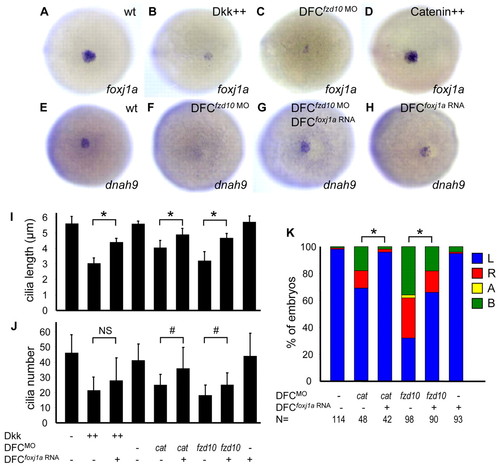
Wnt signaling regulates KV ciliogenesis through modulation of foxj1a expression. (A-D) Wnt signaling is required for foxj1a expression in DFCs. foxj1a expression in DFCs was severely downregulated in Dkk1-expressing zebrafish embryos (B; 37/38) and embryos injected with fzd10 MO into DFCs (C; 24/27) compared with wild-type controls (A). Induction of β-catenin1 did not appear to affect foxj1a expression (D). (E-H) Ectopic expression of foxj1a restores dnah9 levels in embryos with impaired Wnt activity. Downregulated dnah9 expression in DFCfzd10 MO embryos (F; 16/18) was enhanced by DFC-targeted foxj1a overexpression (G; 15/19). Overexpression of foxj1a RNA alone did not significantly alter dnah9 level (H). Shown are ventral views of 90-95% epiboly staged embryos. (I,J) Ectopic expression of foxj1a partially rescues KV cilia length (I) and, to a lesser extent, cilia number (J). Approximately 10-18 embryos for each group were analyzed at the 10-somite stage. Data are represented as mean±s.d. *P<0.01; #P<0.05. NS, not significant (P>0.05). Tg(hsp:dkk1-GFP) and Tg(hsp:β-catenin-GFP) embryos were heat shocked at 50% epiboly for 60 minutes. (K) Ectopic expression of foxj1a partially restores left-sided spaw expression in embryos with impaired Wnt activity. Percentages of spaw expression were determined in 18-to 21-somite staged embryos. N, number of embryos examined. L, left-side; R, right-side; A, absence; B, bilateral.
|

